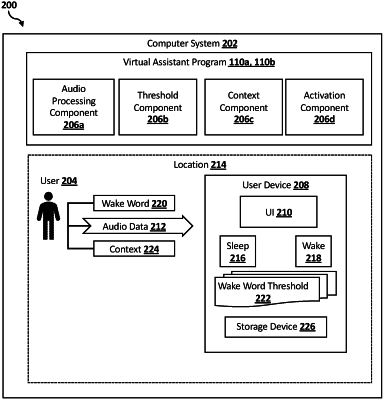| CPC G10L 15/22 (2013.01) [G10L 15/063 (2013.01); G10L 2015/088 (2013.01)] | 17 Claims |

|
1. A computer-implemented method comprising:
receiving an audio data generated by a computing device operating in a sleep mode;
processing the received audio data to determine a context associated with a user of the computing device, wherein the context includes determining at least one interaction between the user of the computing device and a surrounding environment of the computing device based on at least one audio signal from the surrounding environment;
in response to detecting a potential wake word in the received audio data, calculating a wake word confidence score associated with an accuracy of the detected potential wake word;
retrieving a wake word threshold, wherein the wake word threshold is determined based on the context associated with the user of the computing device;
in response to the calculated wake word confidence score exceeding the retrieved wake word threshold, activating a wake mode of the computing device; and
in response to detecting a number of ameliorative actions performed by the user to reduce a functionality of the computing device in the activated wake mode, increasing the retrieved wake word threshold for the context associated with the user of the computing device, wherein the detected number of ameliorative actions performed by the user is selected from the group consisting of detecting a muting of the at least one audio signal from the surrounding environment, detecting a powering down of the computing device, and detecting a user stop command in the received audio data.
|